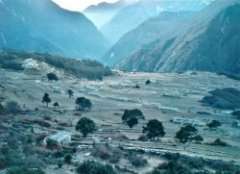|
|
 |

Phortse is a Sherpa village situated at 3840m in the Solu Khumbu
District of Nepal and within the Sagarmatha (Everest) National Park.
Phortse is primarily a farming village with its chief crop being
potatoes and buckwheat, but in the trekking season its men folk,
mainly, are employed as trekking Sherpas and Sirdars, mountain
guides. Whilst the women folk, Sherpani, look after the family,
tend the yaks, land and run the lodges. Phortse was the highest
village off the Dudh Koshi River until trekking in the area
opened up the once seasonal pasture villages of Dole, Machhermo
and Gokyo. Modern times have brought many changes to the region
and to Phortse, though still remote, is beginning to see the
effects of this. The village now has a modern primary school,
Medical Post, Buddhist Temple (Gomba) and village telephone.
More Tea Houses (Lodges) have opened up serving increased numbers
of trekkers. However the village will never be over whelmed by
trekkers due to its location slightly off the trekking trail to
Gokyo or Tengboche and Base Camp Everest.
The village changes remarkable through the seasons. In the
spring when the villagers are busy planting their crops and the
Royal Pheasant struts around showing off its beautiful plumage.
The Musk deer roams around the nearby woods and numerous
rhododendron bushes and trees begin to come into flower.
Summer, the monsoon period in Nepal, changes the village
landscape dramatically. The village looks lovely and green
with potatoes and buckwheat growing. In fact from the Mong La
on the other side of the ravine the village appears to be cover
by a green carpet. In autumn it is time to unearth the crops,
sought and store for the winter. The autumn being the best
trekking season the men are away with trekking or climbing groups
and the ladies are left to toil the soil. In winter, although the
village looks very picturesque with its blanket of snow,
conditions for the Sherpas are tough. The village has no gas or
electricity and no water on tap. Water has to be carried in
plastic containers some distance from the village. However you
will never see a miserable looking Sherpa.
|



